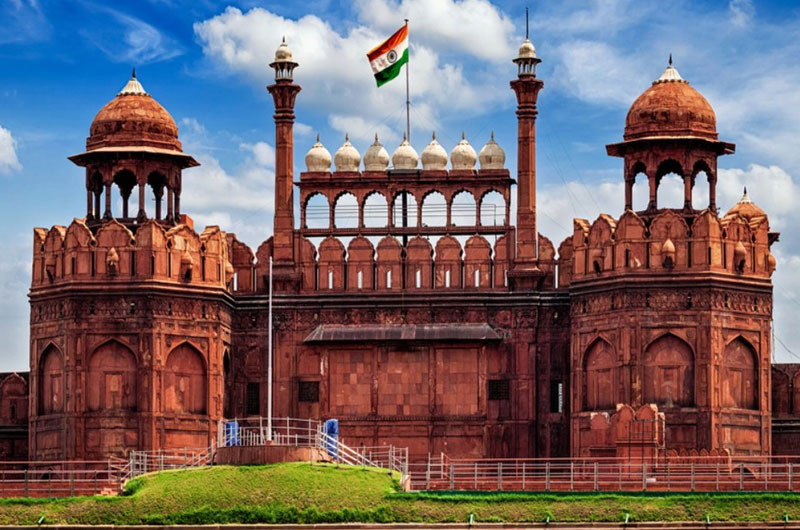
Red Fort Complex: A World Heritage Site
The Red Fort Complex, a UNESCO World Heritage Site, is one of the most prominent landmarks in Delhi, India. This historic fortification served as the main residence of the Mughal emperors for nearly 200 years. Constructed in the mid-17th century, the Red Fort is an architectural masterpiece that symbolizes the zenith of Mughal creativity and power. It is a pivotal cultural and historical site, attracting millions of tourists annually.
Historical Background
- Construction and Purpose
- Built by the Mughal Emperor Shah Jahan in 1638-1648.
- Served as the main residence of Mughal emperors until 1857.
- Originally called “Qila-e-Mubarak” or “Blessed Fort.”
- Architectural Influence
- A blend of Persian, Timurid, and Indian architectural styles.
- Designed by Ustad Ahmad Lahori, the architect of the Taj Mahal.
Architectural Marvel
- Design and Structure
- Encompasses an area of approximately 254.67 acres.
- Surrounded by massive red sandstone walls, standing 33 meters (108 feet) high.
- Includes various palaces, audience halls, and beautiful gardens.
- Notable Structures within the Complex
- Lahori Gate: The main entrance, famous for its massive structure and architectural beauty.
- Delhi Gate: Another grand entrance, used for ceremonial purposes.
- Diwan-i-Aam: Hall of Public Audience, where the emperor addressed the public and heard petitions.
- Diwan-i-Khas: Hall of Private Audience, known for its opulent design and the Peacock Throne.
- Rang Mahal: Palace of Colors, noted for its luxurious interiors and fountains.
- Moti Masjid: Pearl Mosque, a private mosque built by Aurangzeb for his personal use.
- Gardens and Water Features
- Hayat Bakhsh Bagh: The “Life-Bestowing Garden,” featuring beautiful pavilions and a central water channel.
- Nahr-i-Bihisht: The “Stream of Paradise,” a water channel running through the complex, symbolizing the rivers of paradise.
Specialty of the Red Fort Complex
- Architectural Brilliance
- Exemplifies the pinnacle of Mughal architecture.
- Incorporates intricate marble inlays, floral designs, and pietra dura work.
- Historical Significance
- Served as the political and ceremonial center of Mughal governance.
- Site of India’s first Independence Day celebrations on August 15, 1947.
Tourism Aspects
- Visitor Experience
- Guided tours available in multiple languages.
- Sound and light show that narrates the history of the fort.
- Museums within the complex, such as the Indian War Memorial Museum and the Archaeological Museum.
- Nearby Attractions
- Jama Masjid: One of the largest mosques in India, located nearby.
- Chandni Chowk: A bustling market known for its vibrant atmosphere and street food.
- Raj Ghat: Memorial to Mahatma Gandhi, situated close to the fort.
- Events and Festivals
- Republic Day and Independence Day celebrations: Major national events with parades and cultural programs.
- Annual cultural festivals showcasing traditional music, dance, and art forms.
Impact on Locality
- Economic Significance
- Major contributor to Delhi’s tourism industry.
- Provides employment opportunities for local guides, vendors, and artisans.
- Cultural Influence
- Enhances community pride and historical awareness.
- Promotes the preservation of Mughal-era crafts and traditions.
Preservation and Challenges
- Conservation Efforts
- Managed by the Archaeological Survey of India (ASI).
- Ongoing restoration and maintenance to preserve the structural integrity and historical value.
- Environmental Concerns
- Impact of urban pollution and environmental degradation.
- Measures to control air pollution and mitigate damage to the red sandstone structures.
Conclusion
The Red Fort Complex stands as a monumental testament to the grandeur of the Mughal Empire and its architectural genius. As a UNESCO World Heritage Site, it not only serves as a symbol of India’s rich historical and cultural heritage but also plays a vital role in the socio-economic fabric of Delhi. The continuous efforts to preserve and protect this iconic structure ensure that it remains a source of inspiration and pride for future generations.
